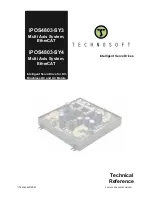
2.4 General Faults
This table describes situations where the soft starter does not operate as expected but does not trip or give a warning.
Symptom
Probable Cause
Soft starter does not respond to commands.
-
If the soft starter does not respond to the
RESET
button on the LCP:
The soft starter may be in Auto On mode and will only accept commands from the remote control
inputs. In Auto On mode, the Auto On LED on the LCP is active. Press the
Hand On
or
Off
button
to enable control via the LCP (this will also send a start or stop command to the MCD 500).
-
If the soft starter does not respond to commands from the control inputs:
The soft starter may be in Hand On mode and will only accept commands from the LCP. When
the soft starter is in Hand On control mode, the Off or Hand On LED on the LCP is active. To
change to Auto On mode, press the
Auto On
button once.
The control wiring may be incorrect. Check that the remote start, stop and reset inputs are con-
figured correctly (=>
Control Wiring
for details).
The signals to the remote inputs may be incorrect. Test the signalling by activating each input
signal in turn. The appropriate remote control input LED should activate on the LCP.
The soft starter will only execute a start command from the remote inputs if the remote reset
input is closed. Check that the remote reset input is also active (the Reset LED on the starter will
be on).
-
If the soft starter does not respond to a start command from either the local or remote con-
trols:
The soft starter may be waiting for the restart delay to elapse. The length of the restart delay is
controlled by Par. 2-11
Restart Delay
.
The motor may be too hot to permit a start. If Par. 2-12
Motor Temperature Check
is set to Check,
the soft starter will only permit a start when it calculates that the motor has sufficient thermal
capacity to complete the start successfully. Wait for the motor to cool before attempting another
start.
The emergency stop function may be active. If Par. 3-3 is set to Emergency Stop and there is an
open circuit on the corresponding input, the MCD 500 will not start. If the emergency stop sit-
uation has been resolved, close the circuit on the input.
The soft starter does not control the motor cor-
rectly during starting.
-
Start performance may be unstable when using a low Motor Full Load Current setting Par.
1-1). This can affect use on a small test motor with full load current between 5 A and 50 A.
-
Power factor correction (PFC) capacitors must be installed on the supply side of the soft
starter. To control a dedicated PFC capacitor contactor, connect the contactor to run relay
terminals.
Motor does not reach full speed.
-
If the start current is too low, the motor will not produce enough torque to accelerate to full
speed. The soft starter may trip on excess start time.
NB!
Make sure the motor starting parameters are appropriate for the application
and that you are using the intended motor starting profile. If Par. 3-3 is set to
Motor Set Select, check that the corresponding input is in the expected state.
-
The load may be jammed. Check the load for severe overloading or a locked rotor situation.
Erratic motor operation.
-
The SCRs in the MCD 500 require at least 5 A of current to latch. If you are testing the soft
starter on a motor with full load current less than 5 A, the SCRs may not latch correctly.
Soft stop ends too quickly.
-
The soft stop settings may not be appropriate for the motor and load. Review the settings of
Pars. 1-10, 1-11, 7-10 and 7-11.
-
If the motor is very lightly loaded, soft stop will have limited effect.
AAC adaptive acceleration control, DC brake and
Jog functions not working
-
These features are only available with in-line installation. If the MCD 500 is installed inside
delta, these features will not operate.
2 Troubleshooting
MCD 500 Service Manual
10
MG.17.L1.02 - VLT
®
is a registered Danfoss trademark
2











































